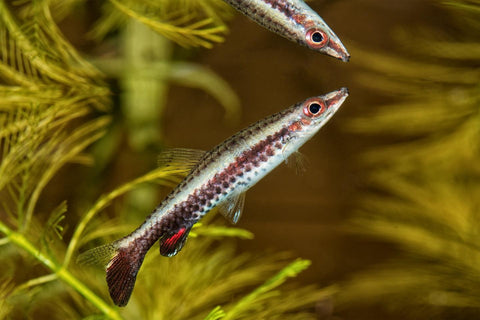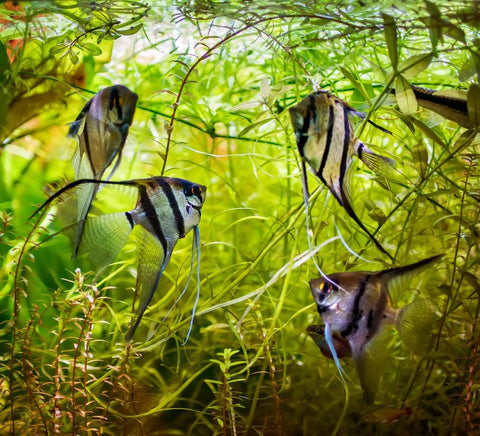The sharp-mouthed tetra, scientifically known as Nannostomus eques, is a fascinating and popular fish species in the aquarium hobby. These small and colorful freshwater fish are native to the waters of South America and enjoy great popularity among aquarists due to their striking appearance and interesting behavior.
Appearance and characteristics
The sharp-mouthed tetra is characterized by its striking appearance. It has an elongated body and a deep, pointed mouth shape, from which it gets its name. The basic coloration varies from greenish-yellow to golden brown, with vertical black stripes running down the sides of the body. There is a conspicuous orange-red spot on the lower part of the gill cover. The tipmouth tetra reaches a maximum length of 5 cm.
The males are somewhat smaller and slimmer than the females. During the courtship phase, the males develop magnificent fin extensions that give them an elegant appearance.
Habitat and behavior
Tipmouth tetras are typically found in slow-flowing waters such as swamps, streams and small rivers. They prefer clean water with a gentle current and dense vegetation that offers them protection.
In an aquarium, they prefer a well-planted tank with plenty of hiding places such as caves and roots. They are peaceful and sociable fish that can be kept well in groups. Observing their behavior is fascinating, as they swim in a group and move synchronously. Sharp-mouthed tetras are very shy and should therefore not be kept with overly active or aggressive fish species.
Nutrition and feeding
Tipmouth tetras are omnivores and eat both plant and animal food. In the wild, they feed on insect larvae, small crustaceans and algae. In the aquarium, they can be fed a varied diet of flake food, live food such as Artemia and Daphnia as well as frozen food such as mosquito larvae and bloodworms.
It is advisable to feed small portions several times a day to ensure that all fish receive sufficient food. A balanced diet will help to maintain the health and colorfulness of the sharp-mouthed tetra.
Breeding and reproduction
Breeding the black tetra can be an exciting challenge for experienced aquarists. A separate breeding tank with specific conditions is required for successful breeding. The tank should be equipped with fine foliage, such as beech leaves, and dense plant cover. The water temperature should be slightly increased to stimulate reproductive activity.
Mating and egg-laying takes place between the plants or on the foliage. The parents should be removed after egg-laying as they tend to eat their own eggs. The eggs usually hatch after 24 to 48 hours and the fry can be fed with finely ground flakes or special rearing food.
Care and keeping
In order to keep the sharp-mouthed tetra healthy and happy, certain care requirements must be met. An aquarium with a minimum size of 100 liters is recommended for a group of around 6 to 8 tetras. It is important to maintain good water quality by carrying out regular water changes.
The water temperature should be between 24 and 28 degrees Celsius, while the pH value should be in the slightly acidic to neutral range of 6.5-7.5. A good filter and sufficient aeration are also important to ensure the water quality.
The lighting in the aquarium should be subdued in order to provide hiding places and allow the sharp-mouthed tetras to recreate their natural environment. Good planting with different types of aquatic plants not only creates a natural environment, but also offers the tetras protection and retreats.
It is important to make sure that the sharp-mouthed tetra is not kept with overly aggressive fish species. Peaceful and smaller species such as other tetras, dwarf cichlids and catfish are good choices.
Diseases and prevention
Spitzmaulzier tetras are generally robust fish, but they can be susceptible to diseases, especially if the water quality is not optimal. Regular water changes and good care are crucial to prevent disease
It is important to observe the fish for signs of disease such as changes in behavior, loss of appetite, changes in fins or abnormal scales. In the event of illness, the affected fish should be isolated immediately and treated accordingly.




Comments (0)
There are no comments for this article. Be the first one to leave a message!